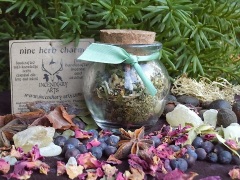
The Nine Herb Charm is perhaps one of the most well known of all the magical charms in Anglo-Saxon leechcraft, particularly since it mentions Woden by name. Taken from a 10th Century Manuscript (latterly named The Lacnunga) the original intention of the metrical charm seems to be to treat poison or to place on a bad wound. I won’t prescribe how to use the herbal mixture as I have to abide by FDA rules on labeling, i.e. this product is not intended to cure any disease nor treat any symptoms. Some of my clients have purchased it simply to place on their altars or burn as an incense offering, while others have found their own magical ways to use the charm.
The ingredients are as follows: Artemisia vulgaris (Mugwort), Planatago major (Plaintain), Nasturtium officianalle (Cress), Solanum nigrum (Black Nightshade) or Echinochloa crus-galli (Cockspur Grass), Urtica dioica (Nettle), Malus sp. (Crab Apple), Anthriscus cerefolium (Chervil), Foeniculum vulgare (Fennel), Matricaria recutita (Roman Chamomile).
I created two types of charm for sale, because one of the ingredients could either be Solanum nigrum or Echinochloa crus-galla – and whether it is one or the other of these two plants – the jury is out. The first, Solanum nigrum, otherwise known as Black Nightshade, is a potent herb, the berries of which can cause drowsiness and death, and this I would keep away from the prying hands of children. It also can cause a rash on the skin if handled. Therefore, since there is a choice for using a benign herb in its place, I also created the family-friendly, Nine Herb Charm, which in place of Solanum nigrum, uses Echinochloa crus-galla (Cockspur Grass).
The charm is packaged in recycled glassware with a well-fitting cork lid, and comes with a printed copy of the Nine Herb Charm. Incendiary Arts’ version also contains essential oils of Fennel, Roman Chamomile and Mugwort.
Below, is the full text of the charm, courtesy of Stephen Pollington,whom I am grateful to for advice and translation of some of the Old English plant names into modern day plants.
Remember, mugwort, what you revealed, what you set out in mighty revelation,’ ‘una’ your are called, oldest of plants, you have might against three and against thirty, you have might against poison and against infection, you have might against the evil that travels around the land. And you, waybread, mother of plants, open to the east, mighty within, carts ran over you, ladies rode over you, brides cried over you, bulls snorted over you, you withstood all then, and you were crushed so may you withstand poison and infection, and the evil that travels around the land.
This plant is called cress, it grew on a stone, it stands against poison, it attacks against pain. It is called nettle, it attacks against poison, it drives off harmful things, casts out poison, this is the plant that fought against the serpent, this one has might against poison, it has might against infection, it has might against the evil that travels round the land. Now, atterlothe, the lesser shall drive out the greater, (and) the greater the lesser until the cure for both be with him. Be mindful now, maythe, of what you made known, of what you finished at alorford so that he should never give up his life for disease
This is the plant which is called crab apple, a seal sent this forth across the sea’s back as a cure for the bite of another poison. These nine spikes against nine poisons. A worm came crawling, he tore a man apart, then Woden took up nine glory-rods, struck the adder then so it flew apart into nine, there apple ended it and its poison so that it would never bend into a house.
Chervil and fennel, two of great might, the wise lord shaped these plants while he was hanging, holy in the heavens he set them and sent them into the seven worlds for poor and for wealthy, as a cure for all. It stands against pain, it attacks against poison, it has might against three and against thirty, against foeman’s hand and against lordly sleight, against bewitching of harmful beings.
Now these nine plants have might against nine powerful diseases Against nine poisons and against nine infections Against the red poison, against the running poison Against the white poison, against the pale blue poison Against the yellow poison, against the green poison Against the pale poison, against the dark blue poison Against the bright poison, against the purple poison Against worm-blister, against water-blister, against thorn-blister, against thistle-blister, against ice-blister, against poison-blister,
if any poison flying from the east or any from the north should come or any from the west over the tribe of men. Odin stood over the ancient malevolent race; I alone know the running rivers and they enclose nine adders, all weeds may now spring up as herbs, seas slide apart, all salt water while I blow this poison from you.
Mugwort, waybread which has opened from the east, lamb’s cress, atterlothe, maythe, nettle, wood sourapple, chervil and fennel, old soap; work the herbs to a powder, mix them with the soap, and with the apple’s juice; make a paste from water and from ashes; take fennel, boil it in the paste and warm it with the mixture when he puts on the salve, both before and after. Sing the charm on each of the herbs thrice before they will be used, and on the apple likewise; and sing the same charm into the man’s mouth and into both ears and onto the wound before he puts on the salve.


